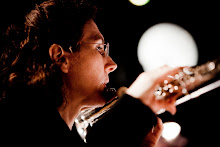Microtonality is the use of intervals smaller than a half-step such as quarter tones, sixth tones, eighth tones and so on.
There are several standard ways in which microtones are used (which may be interconnected):
• As part of a "just" intonation scheme (based on pure intervals instead of equal [keyboard] temperment). Used in a simple way (also known as mean-tone tuning), one plays perfectly in tune in a given key, less so in related keys and totally "out there" in remote keys. So far I have come across no better explanation and description for just intonation than David Doty's Just Intonation Primer. Or click here for an on-line explanation of just intonation.
• As part of a "spectral" scheme where the notes are not tuned according to equal [keyboard] temperment, but according to the intonation of upper partials of a given overtone sequence. This is related to just intonation (and again David Doty's book explains this wonderfully), however in a "just"intonation environment there may be a tonality implied, whereas in "spectral" music a tonality is rarely implied (although there may be a tonal center). Here is an example of how the overtone sequence on our low C is naturally (purely) tuned. The deviation from equal temperment is measured in cents. (Cents are measured by dividing an equal tempered half tone into 100 units. These are marked on most tuners to indicate the degree to which one is sharp or flat.)
◦ 1st harmonic (fundamental): C (no change)
◦ 2nd harmonic C (no change)
◦ 3rd harmonic G: (2 cents sharp)
◦ 4th harmonic C: (no change)
◦ 5th harmonic E: (14 cents flat)
◦ 6th harmonic G: (2 cents sharp)
◦ 7th harmonic Bb (31 cents flat)
◦ 8th harmonic C (no change)
◦ 9th harmonic D (4 cents sharp)
For the deviation up to the 31st harmonic, see Wikipedia's entry on the Harmonic Spectrum.
For tips on how to get these partials in tune without having to resort to watching the cent meter on your tuner (i.e. by ear) read my entry on spectralism.
• Sometimes a composer may invent a tuning system, then it is up to you to determine: a) why/how the composer uses microtones and b) how you should approach them. These questions will help to determine whether or not the composer has included microtones as special "effect"; i.e., should the "de-tuned" notes be given special colors to contrast the "normal" notes, or does the composer want consistency of timbre? This is an important factor in determining fingering (if not already prescribed by the composer).
Once the interpretive questions have been addressed, there comes the time to actually play them. There are several fingering charts available such as Matts Möller's quarter-tone chart. They are good resources but think of them as starting points. My personal advice is to know as many fingerings as possible for a particular note. Be flexible in the choice of fingering because there are several factors to consider when making your choice:
• the speed of the gesture
• the intervallic relationship to its neighboring notes
• the dynamic and tone color
Although each of these is an important consideration, it is crucial to know your end tempo and always have it in mind. I have made the mistake of carefully going through a score and writing in all the "correct" fingerings for microtones, only to have to change them later as I got the piece up to tempo. Practice the notes in tempo, if only two or three at a time to get a feel for this.
Sometimes the solution can be simpler than you think. Turning the flute in or out to "de-tune" a note can work just as well as a really complicated fingering. For example: on a standard flute there is no stable fingering for F 3/4 sharp. If you need a loud, stable tone just play F# and lip up. If you need a quiet clear tone, finger G and lip down. (Of course if you want that hollow, bamboo sound, use low B and half hole the F-key [index finger right hand].)
A note on different flute models: I play on a quarter-tone Kingma System (produced by Osten-Brannen). This is a really great system, and I can recommend it for anyone who wants to play a lot of contemporary music. These flutes are also suitable for all repertoire. However, every flute has the capacity to play microtonally (as we all know, sometimes inadvertently!). Please don't be discouraged from playing the modern repertoire if you have a standard flute, even if you only have a student model with closed holes. There is still repertoire that can be played on student models such as the flute solos by Karlheinz Stockhausen. See my repertoire list for more suggestions.
Subscribe to:
Post Comments (Atom)


No comments:
Post a Comment